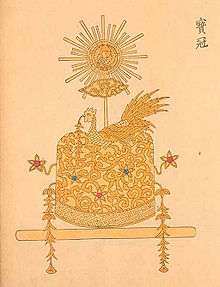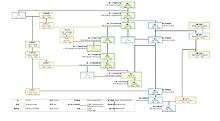Princess Yoshiko (Kōkaku)
| Princess Yoshiko | |||||
|---|---|---|---|---|---|
| Empress consort of Japan | |||||
| Tenure | 1780–1817 | ||||
| Born | 11 March 1779 | ||||
| Died | 11 August 1846 (aged 67) | ||||
| Burial | Senyū-ji | ||||
| Spouse | Emperor Kōkaku | ||||
| Issue |
Prince Masuhito Prince Toshihito | ||||
| |||||
| House | Yamato | ||||
| Father | Emperor Go-Momozono | ||||
| Mother | Konoe Koreko | ||||
| Religion |
Shinto Buddhism (after 1816) | ||||

Princess Yoshiko (欣子内親王 Yoshiko-naishinnō, 11 March 1779 – 11 August 1846) was the empress consort of Emperor Kōkaku of Japan. She enjoys the distinction of being the last daughter of an emperor who would herself rise to the position of empress.[1] When she was later given the title of Empress Dowager, she became the first person to be honored with that title while still living since 1168.[2]
Early life

Princess Yoshiko (欣子内親王 Yoshiko naishinnō) was also known as Onna-Ichi-no-Miya (女一宮 Onna-ichi-no-Miya) in her infancy. She was the only child of Emperor Go-Momozono; and she became the wife of the Emperor's adopted heir, marrying her adoptive stepbrother who would later be known as Emperor Kōkaku. Although her own children died in infancy, she functioned as official mother to the heir who would become Emperor Ninkō.[1]
Family relationships
- Father: Emperor Go-Momozono of Japan (5 August 1758 – 6 December 1779), 118th Emperor of Japan
- Mother: Konoe Koreko (6 December 1760 – 6 November 1783), daughter of Konoe Uchisaki
- Husband and adopted brother: Emperor Kōkaku of Japan (23 September 1771 – 11 December 1840), 119th Emperor of Japan, Yoshiko's second cousin twice removed in the biological male line
- Children: Prince Masuhito (15 February 1800 – 27 April 1800) and Prince Toshihito (25 February 1816 – 14 March 1821)
Empress consort
Yoshiko's father, Emperor Go-Momozono, died without a son when she was ten months old.[1] To avoid dynastic interregnum, Retired Empress Go-Sakuramachi and her chief adviser encouraged the dying emperor to adopt Prince Morohito, whose biological father was Prince Sukehito, the second Prince Kan'in. Morohito, who would be known as Emperor Kōkaku later, acceded to the throne at age eight.
Retired Empress Go-Sakuramachi engaged Yoshiko to the new Emperor. Yoshiko formally became Empress consort to Emperor Kōkaku at age 15. She bore two sons, both of whom died in infancy.
Empress dowager
In 1816, Emperor Ninkō granted Empress Yoshiko the title of Empress Dowager after Emperor Kōkaku abdicated.[2]
Buddhist nun
Shortly after Emperor Kōkaku's death, Dowager Empress Eishō became a Buddhist nun. In 1841, she changed her name to Shin-Seiwa-In (新清和院 Shin-seiwa-in).[2]
Yoshiko died at age 67 and was buried Senyū-ji, which is in Higashiyama-ku, Kyoto. Her memory is officially honored at her husband's mausoleum, which is known as Nochi-no-tsukinowa no misasagi.[3]
Ancestry
| Ancestors of Princess Yoshiko (Kōkaku) | |||||||||||||||||||||||||||||||||||||||||||||||||||||||||||||||||||||||||||||||||||||||||||||||||||||||||||||||||||||||||||||||||||||||||||||||||||||||||||||||||||||||||||||||||||||||||||||||||||||||||||||||||||||||||||||||||||||||||||||||||||||||||||||||||||||||||||||||||||||||||||||||||||||||||||||||||||||||||||||||||||||||||||||||||||||||||||||||||||||||||||||||||||||||||||||||||||||||||||||||||||||||||||||||||||||||||||||||||||||||||||||||||||||||||||||||||||
|---|---|---|---|---|---|---|---|---|---|---|---|---|---|---|---|---|---|---|---|---|---|---|---|---|---|---|---|---|---|---|---|---|---|---|---|---|---|---|---|---|---|---|---|---|---|---|---|---|---|---|---|---|---|---|---|---|---|---|---|---|---|---|---|---|---|---|---|---|---|---|---|---|---|---|---|---|---|---|---|---|---|---|---|---|---|---|---|---|---|---|---|---|---|---|---|---|---|---|---|---|---|---|---|---|---|---|---|---|---|---|---|---|---|---|---|---|---|---|---|---|---|---|---|---|---|---|---|---|---|---|---|---|---|---|---|---|---|---|---|---|---|---|---|---|---|---|---|---|---|---|---|---|---|---|---|---|---|---|---|---|---|---|---|---|---|---|---|---|---|---|---|---|---|---|---|---|---|---|---|---|---|---|---|---|---|---|---|---|---|---|---|---|---|---|---|---|---|---|---|---|---|---|---|---|---|---|---|---|---|---|---|---|---|---|---|---|---|---|---|---|---|---|---|---|---|---|---|---|---|---|---|---|---|---|---|---|---|---|---|---|---|---|---|---|---|---|---|---|---|---|---|---|---|---|---|---|---|---|---|---|---|---|---|---|---|---|---|---|---|---|---|---|---|---|---|---|---|---|---|---|---|---|---|---|---|---|---|---|---|---|---|---|---|---|---|---|---|---|---|---|---|---|---|---|---|---|---|---|---|---|---|---|---|---|---|---|---|---|---|---|---|---|---|---|---|---|---|---|---|---|---|---|---|---|---|---|---|---|---|---|---|---|---|---|---|---|---|---|---|---|---|---|---|---|---|---|---|---|---|---|---|---|---|---|---|---|---|---|---|---|---|---|---|---|---|---|---|---|---|---|---|---|---|---|---|---|---|---|---|---|---|---|---|---|---|---|---|---|---|---|---|---|---|---|---|---|---|---|---|---|---|---|---|---|---|---|---|---|---|---|---|---|---|---|---|---|---|---|---|---|---|---|---|---|---|---|---|---|---|---|---|---|---|---|---|---|---|---|---|---|---|---|---|---|---|---|---|---|---|---|---|---|---|---|---|---|---|
| |||||||||||||||||||||||||||||||||||||||||||||||||||||||||||||||||||||||||||||||||||||||||||||||||||||||||||||||||||||||||||||||||||||||||||||||||||||||||||||||||||||||||||||||||||||||||||||||||||||||||||||||||||||||||||||||||||||||||||||||||||||||||||||||||||||||||||||||||||||||||||||||||||||||||||||||||||||||||||||||||||||||||||||||||||||||||||||||||||||||||||||||||||||||||||||||||||||||||||||||||||||||||||||||||||||||||||||||||||||||||||||||||||||||||||||||||||
See also
Notes
References
- Fujita, Satoru. (1994). Bakumatsu no Tennō. Tokyo: Kodansha. ISBN 4-06-258026-8
- Ponsonby-Fane, Richard Arthur Brabazon. (1959). The Imperial House of Japan. Kyoto: Ponsonby Memorial Society. OCLC 194887
- ___________. (2002). Genealogies of the Empresses of Japan (歴代皇后人物系譜総覧 Rekidai kōgō jinbutsu keifu sōran). Tokyo: Shin Jinbutsu Ōraisha (新人物往来社). ISBN 978-4-404-03024-5; OCLC 51932430
| Japanese royalty | ||
|---|---|---|
| Preceded by Princess Yukiko |
Empress consort of Japan 1794–1816 |
Succeeded by Empress Eishō (Posthumously Fujiwara no Tsunako) |
| Preceded by Unknown |
Empress Dowager of Japan 1816–1841 |
Succeeded by Empress Eishō (Posthumously Fujiwara no Tsunako) |